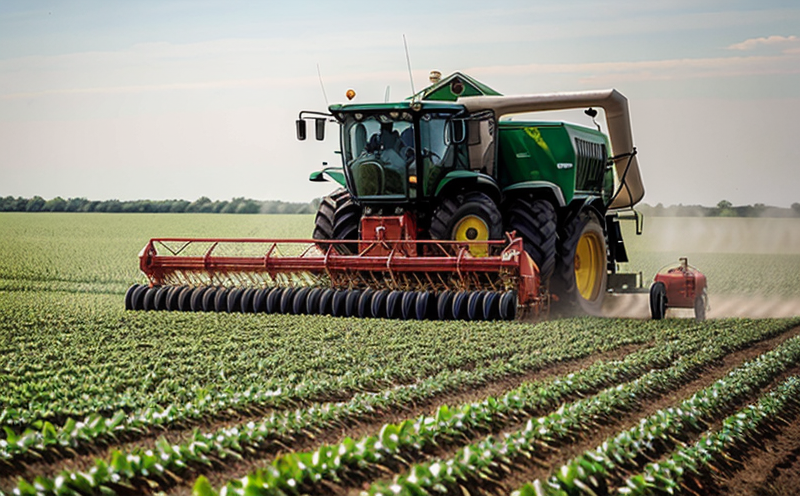Photosynthetic Efficiency Testing
Photosynthetic efficiency testing plays a crucial role in agricultural and forestry sectors by providing insights into how plants convert light energy into chemical energy through photosynthesis. This test is essential for understanding the productivity of crops and optimizing resource use, which are critical factors in modern agriculture.
The efficiency at which a plant can capture sunlight and turn it into biomass is directly related to its yield potential. By measuring this parameter, we aim to identify optimal growing conditions, genetic traits that enhance photosynthetic performance, and strategies for improving crop productivity. This testing method is not only beneficial for enhancing agricultural practices but also aids in sustainable forestry management.
Photosynthetic efficiency can be influenced by various factors including genetics, environmental conditions (light intensity, temperature), nutrient availability, water stress, and more. Our laboratory uses state-of-the-art equipment to conduct these tests under controlled conditions that replicate real-world scenarios as closely as possible. This ensures accurate results which are essential for making informed decisions in both research and commercial settings.
One key aspect of our testing methodology involves measuring the rate of CO2 fixation during photosynthesis, often referred to as the net assimilation rate. Another important parameter is the quantum yield (ΦPSII), which indicates how efficiently chlorophyll captures photons. These measurements help us determine the overall health and productivity of plants.
For accurate testing, it's necessary to collect fresh samples from the field or controlled growth environments. Specimen preparation typically includes washing leaves thoroughly with distilled water followed by blotting them dry before placing them in the measurement chamber. The equipment used for this test includes advanced spectroradiometers capable of measuring light intensity and quantum yield, along with gas exchange chambers designed to maintain stable CO2 concentrations.
The results from our photosynthetic efficiency tests are reported comprehensively, detailing observed rates of CO2 fixation, quantum yields, and any other relevant metrics. This data can then be used by researchers and industry professionals to develop new varieties of crops better suited for specific environments or improve current practices aimed at increasing yield without compromising sustainability.
Accurate photosynthetic efficiency testing is recognized globally as a standard practice within the agricultural community. It helps ensure that products meet international standards set forth by organizations such as ISO, ASTM, and EN, ensuring consistency across different regions and markets.
- International Acceptance: Results from these tests are widely accepted in scientific journals and regulatory bodies worldwide.
- Globally Recognized: Our methodologies align with international guidelines established by leading institutions like the International Organization for Standardization (ISO).
In conclusion, photosynthetic efficiency testing is an indispensable tool for anyone involved in agriculture or forestry. It provides invaluable information about plant health and productivity, enabling better decision-making processes that contribute to more sustainable agricultural practices.
Benefits
Conducting photosynthetic efficiency tests offers numerous benefits across various stakeholders within the agricultural sector:
- Enhanced Crop Productivity: By identifying factors that limit photosynthesis, we can develop strategies to maximize crop yields. This leads to increased food production and improved economic returns for farmers.
- Promotes Sustainable Practices: Understanding how efficiently plants convert sunlight into biomass helps promote sustainable agricultural practices by minimizing resource use while maximizing output.
- Supports Research & Development: Accurate data from these tests supports ongoing R&D efforts aimed at developing new crop varieties or improving existing ones. This contributes to innovation and advancement within the industry.
- Aids Compliance: With increasing regulatory pressures around environmental impact, accurate photosynthetic efficiency testing ensures compliance with local and international standards.
In summary, photosynthetic efficiency testing is not just about measuring light absorption; it's about driving improvements in agricultural practices that benefit both producers and consumers alike.
International Acceptance and Recognition
- Global Consensus: The importance of accurate photosynthetic efficiency measurements is widely recognized globally. Standards set by international bodies like ISO provide a benchmark for consistency in results across different regions.
- Scientific Validation: Results from our testing are frequently cited in reputable scientific publications, contributing to advancements in agricultural science and technology.
The widespread acceptance of these tests underscores their significance in the broader context of sustainable agriculture. By aligning with international standards, we ensure that our findings are credible and relevant worldwide.
Competitive Advantage and Market Impact
- Enhanced Reputation: Offering precise photosynthetic efficiency testing enhances the reputation of businesses operating in this sector. It demonstrates commitment to quality and innovation, attracting both clients and investors.
- Informed Decision-Making: Accurate data from these tests enables stakeholders to make informed decisions that can lead to competitive advantages. For instance, identifying high-yielding crop varieties early on gives companies a head start in the market.
The ability to provide reliable and accurate photosynthetic efficiency testing also opens up opportunities for collaboration with leading research institutions and international organizations. This exposure further strengthens our position within the industry, fostering innovation and growth.





